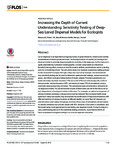Increasing the Depth of Current Understanding: Sensitivity Testing of Deep-Sea Larval Dispersal Models for Ecologists
| dc.contributor.author | Ross, Rebecca | |
| dc.contributor.author | Nimmo-Smith, Alex | |
| dc.contributor.author | Howell, Kerry | |
| dc.date.accessioned | 2016-11-30T15:15:15Z | |
| dc.date.accessioned | 2016-11-30T15:37:00Z | |
| dc.date.available | 2016-11-30T15:15:15Z | |
| dc.date.available | 2016-11-30T15:37:00Z | |
| dc.date.issued | 2016-08-30 | |
| dc.identifier.issn | 1932-6203 | |
| dc.identifier.issn | 1932-6203 | |
| dc.identifier.other | ARTN e0161220 | |
| dc.identifier.uri | http://hdl.handle.net/10026.1/8056 | |
| dc.description.abstract |
Larval dispersal is an important ecological process of great interest to conservation and the establishment of marine protected areas. Increasing numbers of studies are turning to biophysical models to simulate dispersal patterns, including in the deep-sea, but for many ecologists unassisted by a physical oceanographer, a model can present as a black box. Sensitivity testing offers a means to test the models' abilities and limitations and is a starting point for all modelling efforts. The aim of this study is to illustrate a sensitivity testing process for the unassisted ecologist, through a deep-sea case study example, and demonstrate how sensitivity testing can be used to determine optimal model settings, assess model adequacy, and inform ecological interpretation of model outputs. Five input parameters are tested (timestep of particle simulator (TS), horizontal (HS) and vertical separation (VS) of release points, release frequency (RF), and temporal range (TR) of simulations) using a commonly employed pairing of models. The procedures used are relevant to all marine larval dispersal models. It is shown how the results of these tests can inform the future set up and interpretation of ecological studies in this area. For example, an optimal arrangement of release locations spanning a release area could be deduced; the increased depth range spanned in deep-sea studies may necessitate the stratification of dispersal simulations with different numbers of release locations at different depths; no fewer than 52 releases per year should be used unless biologically informed; three years of simulations chosen based on climatic extremes may provide results with 90% similarity to five years of simulation; and this model setup is not appropriate for simulating rare dispersal events. A step-by-step process, summarising advice on the sensitivity testing procedure, is provided to inform all future unassisted ecologists looking to run a larval dispersal simulation. | |
| dc.format.extent | e0161220-e0161220 | |
| dc.format.medium | Electronic-eCollection | |
| dc.language | en | |
| dc.language.iso | en | |
| dc.publisher | Public Library of Science (PLoS) | |
| dc.relation.replaces | http://hdl.handle.net/10026.1/8054 | |
| dc.relation.replaces | 10026.1/8054 | |
| dc.subject | Animals | |
| dc.subject | Computer Simulation | |
| dc.subject | Ecology | |
| dc.subject | Ireland | |
| dc.subject | Larva | |
| dc.subject | Marine Biology | |
| dc.subject | Models, Biological | |
| dc.subject | Oceans and Seas | |
| dc.subject | United Kingdom | |
| dc.title | Increasing the Depth of Current Understanding: Sensitivity Testing of Deep-Sea Larval Dispersal Models for Ecologists | |
| dc.type | journal-article | |
| dc.type | Journal Article | |
| plymouth.author-url | http://gateway.webofknowledge.com/gateway/Gateway.cgi?GWVersion=2&SrcApp=PARTNER_APP&SrcAuth=LinksAMR&KeyUT=WOS:000382877200018&DestLinkType=FullRecord&DestApp=ALL_WOS&UsrCustomerID=11bb513d99f797142bcfeffcc58ea008 | |
| plymouth.issue | 8 | |
| plymouth.volume | 11 | |
| plymouth.publication-status | Published | |
| plymouth.journal | PLOS ONE | |
| dc.identifier.doi | 10.1371/journal.pone.0161220 | |
| plymouth.organisational-group | /Plymouth | |
| plymouth.organisational-group | /Plymouth/Faculty of Science and Engineering | |
| plymouth.organisational-group | /Plymouth/Faculty of Science and Engineering/School of Biological and Marine Sciences | |
| plymouth.organisational-group | /Plymouth/PRIMaRE Publications | |
| plymouth.organisational-group | /Plymouth/REF 2021 Researchers by UoA | |
| plymouth.organisational-group | /Plymouth/REF 2021 Researchers by UoA/UoA07 Earth Systems and Environmental Sciences | |
| plymouth.organisational-group | /Plymouth/Research Groups | |
| plymouth.organisational-group | /Plymouth/Research Groups/Marine Institute | |
| plymouth.organisational-group | /Plymouth/Users by role | |
| plymouth.organisational-group | /Plymouth/Users by role/Academics | |
| plymouth.organisational-group | /Plymouth/Users by role/Researchers in ResearchFish submission | |
| dc.publisher.place | United States | |
| dcterms.dateAccepted | 2016-08-02 | |
| dc.identifier.eissn | 1932-6203 | |
| dc.rights.embargoperiod | No embargo | |
| rioxxterms.versionofrecord | 10.1371/journal.pone.0161220 | |
| rioxxterms.licenseref.uri | http://www.rioxx.net/licenses/all-rights-reserved | |
| rioxxterms.licenseref.startdate | 2016-08-30 | |
| rioxxterms.type | Journal Article/Review | |
| plymouth.oa-location | http://journals.plos.org/plosone/article?id=10.1371/journal.pone.0161220 |


